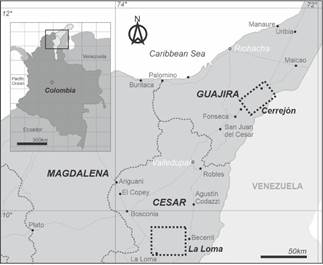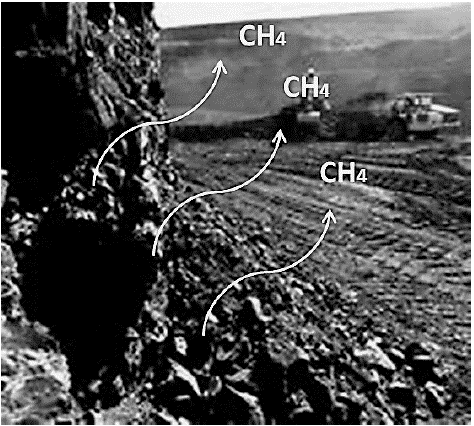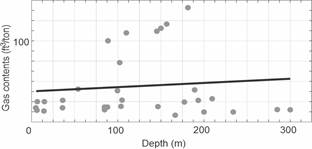1. Introduction
Colombia is one of the largest coal exporters and the open pit mining in the Colombian Caribbean accounts for more than 90% of domestic production. The open pits are located in the provinces of Guajira and Cesar with annual productions of 33 and 45 million tons respectively. Associated with coal mining is methane gas (CH4) which in Colombia has been studied from three perspectives: 1) as the cause of frequent mining accidents, 2) as a source of natural gas and 3) as a greenhouse gas. In the wake of global warming, Colombia as a signatory of the United Nations Framework Convention on Climate Change in 2015-Paris Agreement [1] undertook to periodically measure and report its greenhouse gas emissions (GHG). This is why the country has been measuring and reporting emissions in recent years at the sectoral and province level. Fugitive methane gas emissions from coal mining are part of GHG emissions and belong to the energy module as contemplated by the Intergovernmental Panel on Climate Change (IPCC).
The calculations of fugitive or passive methane gas emissions associated with coal mining reported by Colombia prior to 2015, have been carried out based on international tables (level 1 of complexity), established by the IPCC. This country has advanced considerable measurements of coal bed methane (CBM), and this research suggests calculating direct measurements from CBM projects and proposes an estimate of methane gas emissions with a level of complexity 2, according to IPCC guidelines [2].
This research presents the contrast between the estimation of fugitive methane gas emissions by applying level 1 international factors (indirect measurements) and the direct level 2 measurements, using canister desorption equipment, for the 2015 coal production in the Colombian Caribbean (Cerrejón in Guajira and La Loma in Cesar) (Fig. 1). This is to show that fugitive emissions associated with coal extraction could be lower than the emissions that have been reported in Colombia because Colombian coals have below-average methane gas content than coals with a similar range found in basins in major coal-producing countries. Regardless of how it is calculated, methane emissions associated with coal mining should be measured, reported and where possible decreased.
One possible limitation in this study is that level 2 measurements require drilling cores and only a few reliable CBM wells are available in each province.
2. Fugitive emissions of greenhouse gases (GHG)
The climate change that the planet has been experiencing is attributed to the increase of greenhouse gases in the atmosphere, with higher emissions than the biosphere and oceans can assimilate, leading to the entrapment of infrared radiation in atmosphere beyond what is necessary. GHGs act as a curtain that traps that solar radiation and prevents the heat from the sun from leaving the planet, so the earth heats up causing climate change or global warming.
Of the greenhouse gases, the most impactful are Carbon Dioxide (CO2) and Methane (CH4). Methane is one of the gases that contributes the most to the greenhouse effect, being 25 times more harmful than CO2 in warming the atmosphere (Global Warming Potential) [6]. GHG emissions are divided into two large groups, emissions caused by burning and fugitive emissions. Coal bed methane gas (CBM-CMM) is part of fugitive emissions because they are formed not by fuel burning, but by the release of naturally trapped gases that are emitted into the atmosphere by anthropic action; this happens with the methane gas associated with coal that is emitted into the atmosphere slowly and by little unnoticed when the ore is extracted by man through the processes of mining, storage and transport of coal (Fig. 2). Fugitive gas emissions associated with coal extraction account for nearly 5% of energy-related GHGs [3,8].
3. Geology
Guajira. The Guajira coal beds are found in Central Cerrejón in the Paleocene-age Cerrejón formation with 40 to 50 layers of coal interbedded with shales and thin sandstones and limestones. The Cerrejón Formation has been divided into three levels, called lower, middle and upper; about 12 coal beds at the lower level called M20 to M60, 15 coal beds at the mid-level called M75 to M113 and 14 coal beds have been identified at the top level denominated from M115 to M175, classified as Bituminous high volatile A, B and C [7]. Fig. 3 shows the coal beds from base to top at the different levels of the Cerrejón Formation, with their name and thickness. The exploitation system corresponds to the open pit mining system which is characterized by having a large number of banks and levels, allowing attacking several coal beds simultaneously at once.
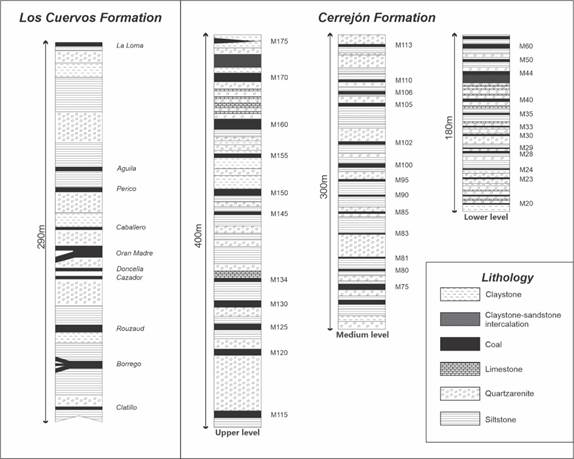
Source: Adapted from Ingeominas, 2012 [7].
Figure 3 Los Cuervos formation stratigraphy in La Loma, Cesar province (left). Cerrejón formation stratigraphy in Cerrejón, Guajira province (right).
Cesar. The Cesar coals are located in the muddy Los Cuervos formation that is part of the Cesar Ranchería basin. CBM's studies have focused on the La Loma syncline located in the center of the Cesar province, between the municipalities of El Paso, Chiriguaná and La Jagua de Ibirico. It covers an area of 180 km2. The Los Cuervos formation contains the coals and more than 60 coal beds have been identified (see Fig. 3). The thickness of the coal sequence varies between 200 m and 420 m.
4. Methodology for calculating emissions
Emissions were calculated from desorbed gas measurements in samples of coal bed methane exploratory gas wells (CBM).
Gas contents were plotted against depth to create a gradient line. In this research, CBM measurements are taken as equivalent to methane emissions. In Guajira, CBM's exploratory wells focused on the surroundings of Central Cerrejón. Just five wells were available there: Well 3, Well 4, Well 7, Well 8 and Well 9, which served as the basis for the content curve (Figs. 5 and 6) [12].
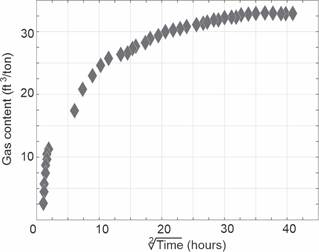
Source: The Authors.
Figure 4 CBM well sample desorption curve. The accumulated content in ft3/ton is plotted against the square root of time in hours.
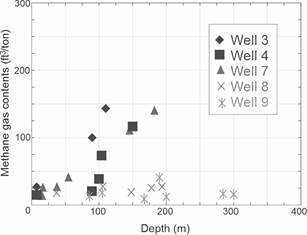
Source: The Authors.
Figure 5 Methane gas contents from five CBM Wells in Cerrejón (Guajira). Gas content (ft3/ton) vs depth (m).
At Cesar province, CBM's exploratory wells focused on the La Loma sector. Four wells were analyzed there: CP-02, CV-04, CV-05 and CP-09; these wells served as the basis for the emissions curve. For both basins, emission calculations were made for two emissions calculations levels, Level 1 and Level 2 [8].
Level 1. So far in Colombia, to estimate the emissions of methane gas generated by coal mining, the Level 1 IPCC methodology (1996) is used, which involves coal production and an emission factor resulting from research carried out in the countries that have made significant progress on the issue (Australia, USA, Poland, Mexico and China). Level 1 calculations are taken from Table 1 as proposed by the IPCC in which emission calculations are taken from international measurements (tables) that assume contents depending on the range of coal and depth (for underground mining) and the overburden (for open pits) mainly, as suggested by the Intergovernmental Panel on Climate Change [3] (Table 1).
Table 1 Emission factors for underground and open pit mining [3].
| IPCC LEVEL 1 COAL EXTRACTION EMISSION FACTOR | |||||
|---|---|---|---|---|---|
| Underground mining | Open pit mining | ||||
| Depth (m) | m3/ton | ft3/ton | Thickness of overburden (m) | m3/ton | ft3/ton |
| 0 to 200 (low) | 10 | 353.15 | 0 to 25 (low) | 0.3 | 10.593 |
| 200 to 400 (medium) | 18 | 635.58 | 25 to 50 (medium) | 1.2 | 42.372 |
| >to 400 (high) | 25 | 882.75 | >50 (high) | 2 | 70.62 |
Source: IPCC, 1996 [2].
In coal mining, initial research on methane gas was conducted to address mining safety problems from gas explosions, but currently it is also used to calculate fugitive emissions of greenhouse gases as a result of coal mining. In coal open pits the emission factor depends on the thickness of the overburden or layers above coal beds.
To do the calculations at Level 1, the characteristics of the mines should be considered as depth and production by basin (Table 1). For Colombia open pit mining, 2 m3/ton is taken as emission factor (average emission factor according to IPCC), since it is considered that in most open pit in Colombia, the layer (overburden) above the coalbed has a thickness above 50 m.
The calculations presented in the results for Level 1 consider: the method of exploitation applied, the depth of mines in each basin and the conventional formula, which determines emissions (EG) from coal production (CP); the emission factor (EF) and the correction factor (CF-0.67x10-6 Gg/m3) are also used to obtain emissions in Gigagrams (Gg=1000 tons) (eq. 1), so:
Finally, the methane emissions in Gigagrams of CH4 are converted to tons of CO2e by multiplying by 25 (Global Warming Potential of the CH4) and by 1,000 (Gigagrams to tons) [8].
Level 2. Due to the increase in gas consumption, and due to the decline in reserves, Colombia has advanced different explorations of coal bed methane (CBM). The CBM wells in Colombia could already add up to more than a hundred, and with this information it is possible to get a better idea of the contents in different regions and the variables affecting the gas content.
The CBM gas measurement procedure is explained as follow: Once the core of the coal sample is removed from the CBM well, it is immediately fed into an airtight container known as the Canister Desorption System. The measurement process comprised three different methods considering that the total content of the gas associated with coal is the sum of three components as well [9,10]:
Lost gas:gas corresponding to the coalbed gas leaked, between the time the coalbed is penetrated by the drilling and the time when the sample is inserted and sealed inside the canister.
Desorbed (measured) gas: gas that is desorbed from the carbon matrix and is determined using the canisters, in which coal samples are introduced and sealed. Subsequently this canister is connected to a burette, in order to measure the degassing of the coal, opening the valve that allows the gas to be measured by the displacement of the water in a volumetric column in the burette at reservoir temperature and atmospheric pressure. As the gas desorbs, the accumulated gas is plotted against time (Fig. 4).
Residual gas: gas that remains absorbed into the coal matrix, after the desorption test has been completed. It is extracted by putting the sample in an airtight mill and measuring the amount of gas with the burette system used to determine the desorbed gas [10,11].
As several wells have been made in each coal basin (province), a gas content vs depth curve can be generated for each basin. Methane gas content equated with the emission factor from desorption tests conducted in CBM exploration studies (Fig. 5 and 6).
Once the emission factor is known, the formula suggested by the IPCC (1997) is used for the calculation of methane emissions (EG) as follow:
The conversion factor is used to carry methane volumes (m3) to weight (Gg) (eq. 2). Then the CH4 is converted to CO2e (Table 2) [3].
Table 2 Calculation of Methane emissions Level 1 for Guajira and Cesar.
| Basin | Coal production 2015 (ton) | Conversion factor (Gg/m3) | Emission factor (m3/ton) | Total emission Level 1 (Gg) CH4 | |
|---|---|---|---|---|---|
| Guajira | 33,703,409 | 0.00000067 | 2 | 45.16 | |
| Cesar | 45,422,176 | 0.00000067 | 2 | 60.87 | |
| Total | 79,125,585 | 106.03 | |||
| Total Tons of CO2 equivalent | 2,650,500 | ||||
Source: The Authors.
So far, the calculations in Colombia have been made using level 1 of the IPCC methodology in which the emission factor depends on the depth of exploitation in underground mining and the thickness of the layers above coalbeds [3]; however, it is believed that the country has sufficient information to make the calculations from the CBM exploration made in Colombia, which would amount to an IPCC Level 2.
5. Results
Guajira. Information from the Guajira province is focused on the surroundings of the central Cerrejón area. Five wells were analyzed there: Well 3, Well 4, Well 7, Well 8 and Well 9, which served as the basis for the gas content curve (Fig. 5). In Fig. 5, each sign represents a coal bed.
From Fig. 5, it was determined the trend line in Fig. 6 presenting the average methane gas contents at different depths. From Fig. 6 it was found that between 0 and 200 m deep, the gas content is between 40 and 50 ft3/ton, which is equivalent to 1.13 - 1.41 m3/ton. Between 200 and 350 m deep the gas content is between 50 and 60 ft3/ton, which is equivalent to 1.41 - 1.7 m3/ton.
The average depth reached for the surface mining (open pits) in the Guajira is close to 180 meters, the value of methane gas content to be applied for the basin is 48 ft3/ton, which is equal to 1.36 m3/ton (Fig. 6) (Table 2).
Cesar. Information from the Cesar province was taken from the study entitled "Exploration of coal-associated gas in Colombia's coal basins, Phase I, 2009" [12]. The study focused on the La Loma sector. Four wells were analyzed there: CP-02, CV-04, CV-05 and CP-09; these wells served as the basis for determining the trend line for the Cesar Basin.
The average contents of methane gas were calculated at different depths: Between 0 and 200 m deep the gas content is between 10 and 60 ft3/ton, equivalent to 0.28 to 1.7m3/ton. Between 200 and 400 m deep, the gas content is between 60 to 125 ft3/ton, which is equivalent to 1.7 - 3.54 m3/ton. Assuming that most of the mining in Cesar reaches an average depth of 300 m, the value to apply for the basin is 90 ft3/ton which is equivalent to 2.55 m3/ton of coal (Table 3).
Table 3 Calculation of methane emissions from open pit mining in the Colombian Caribbean with the proposed methodology (Level 2).
| Basin | Coal production per year 2015 (ton) | Average gas content (feet3/ton) | Average gas content (m3/ton) | Surrounding strata emission factor (m3/ton) | 30% Residual gas (m3/ton) | Total emitted gas (m3/ton) | Conversion-factor (Gg/106 m3) | Total emission Level 2 (Gg CH4) |
|---|---|---|---|---|---|---|---|---|
| Guajira | 33,703,409 | 48 | 1.36 | - | 0.41 | 0.95 | 0.00000067 | 21.45 |
| Cesar | 45,422,176 | 90 | 2.55 | - | 0.76 | 1.79 | 0.00000067 | 54.47 |
| Total | 79,125,585 | 75.92 | ||||||
| Total Tons of CO2 equivalent | 1,898,000 | |||||||
Source: The Authors.
The results of the emission calculations are presented next for Level 1 and Level 2 of IPCC.
Calculation of level 1 emissions. The emissions calculation was made for 2015, considering the coal produced during that year by coal basin (province); The emission factor taken for open pit mining was 2 m3/ton for Guajira and Cesar because, although the depth of the mines varies, the average thickness of the overburden is over 50 m (see Table 1).
Total emissions at level 1 for Guajira basin would be 45.16 Gg and for the Cesar-Ranchería basin would be 60.86 Gg, therefore open pit mining in the Colombian Caribbean for 2015 added 106.03 Giga grams of methane, which is about 2,650,500 tons of CO2 equivalent (Table 2) which equates to more than 50% of total national methane emissions from coal mining at level 1 [8].
Calculation of level 2 emissions. To estimate the emission factor per basin for Level 2 in Guajira and Cesar, it was based on CBM exploration projects in which samples were obtained from different coalbeds drilled by exploration Wells [13]. These results were measured by determining the amount of gas using canister desorption equipment, following the methodologies of the US Mining Office (USBM) [11]. Using depth vs methane gas content, a diagram was made to find the average line in each of the basins, which would allow to observe the dispersion of amount of methane gas around the line (Figs. 4, 5 and 6).
With the methane gas content determined from CBM exploration Wells in Guajira and Cesar coal zones, Level 2 emissions were established, which are presented in Table 3.
Table 3 is explained in detail next in order to understand the final emission results in Colombia for the year 2015: Coal production for each province (basin) is presented in the second column. The emission factor is calculated from the average gas measured at the average depth of mining (third and fourth column) (Fig. 6). To the above, it was added the emissions that would produce the surrounding strata of the rocky massif resulting from the disturbance and subsidence caused by the mining. As the type of mining is open pits, the contribution of the surrounding strata is considered minimal, consequently it was not added because the IPCC [3] has recognized that the influence of the open pit mining is small on the surrounding massif or strata in terms of emissions (Table 3 - column five). Emissions are also subtracted by 30% corresponding to the residual gas emitted and reported only during the burning of coal (column 6). The three emissions mentioned above constitute the total of gas emitted during the exploitation of coal per province (column 7). As the calculation has so far been made in volume, this must be carried by weight which is the way emissions are represented worldwide. Therefore, the total volume emitted (in m3/ton) is multiplied by a conversion factor (0.67x10-6 Gg/m3) (column 8-Table 3) to obtain the total emissions in Gigagrams (column 9). A Gigagram equals 109 grams or 1,000 tons and is the standard unit for worldwide weight comparisons of greenhouse gas emissions [2].At level 2, total methane emissions in Guajira and Cesar would be 75.92 Gigagrams of methane equivalent to 1,898,000 tons of CO2 equivalent (Table 3), corresponding to about 50% of total fugitive methane emissions associated with coal mining in Colombia. Since these two provinces make up almost all of the country's surface mining, then open pit mining would contribute 50% of total coal fugitive emissions [8]
6. Discussion
Since the world worries about global warming, the understanding and reduction of emissions to the atmosphere become more important. The fugitive emissions from coal mining in Colombia are significant (between 1.5 and 4 million tons of CO2 equivalent depending on the investigation) since the country is one the main coal exporters [13].
The results of this research support the assumption that total emissions calculated from open pit mining using CBM-Level 2 studies (75.92 Gg), is less than the value calculated from international tables-Level 1 (106.02 Gg) at about 30% (Tables 2 and 3). This is partly explained by the exhumation of the coals related to the intense tectonics of the andes and by the proximity to the surface. As the overburden rocks eroded, the confining pressure was reduced and some of the gas escaped [10].
The results highlight the deduction that coal bed methane gas content in Colombia's basins is not as high as the big coal producers, like China or the USA, and for that reason the calculations of emissions should not be done from international tables of coal gas content, but from direct measurements on cores using canister desorption equipment [12,15]. Because the information of methane gas content in the different basins of the country is available from CBM exploration, the emissions calculations can be changed from level 1 to level 2 proposed by the IPCC methodology. The main reason is that when making the calculations to Level 1, with international tables like the one suggested by the IPCC (1996) [2], the coal fugitive emissions could be over-sized and could compromise the country in greenhouse gas (methane) emissions above the Colombian context [8].
Another important result is that the methane fugitive emissions are higher than previously thought due to the open pit mining, this happens because the Colombian open pits are deeper than average (between 180 m in Guajira and 300 m in Cesar) and for that reason the emissions for Level 1 would be higher, and because of that, it would be necessary to use the highest emissions factor (2 m3/ton) established for the IPPC (Table 1) [2,13]. The gas content values obtained in this research using Level 2 are close to those obtained in other studies, where it has also been noticed that in Colombia the gas content is directly related to depth [10,14,15].
As gas emissions in mines are dynamic, and increase while mining works deepen, gas contents should be updated by incorporating information on new drillings. Additionally, information on the gas contents in the surrounding rocks should also be obtained in order to increase the accuracy of the calculations by eliminating unrealistic assumption of methane gas content from surrounding strata.
7. Conclusions
Emission calculations from Colombian Caribbean open pit mining which have been made based on international gas content tables (Level 1) (106.02 Gg), exceed the contents found in direct measurements (75.92 Gg) in 30%.
Emissions from Guajira and Cesar provinces, for Level 1 converted to CO2 equivalent, are 1,129,000 and 1,521,500 tons respectively, for a total of 2,650,500 tons of CO2 equivalent.
Emissions for Guajira and Cesar, for Level 2 converted to CO2 equivalent, are 536,250 and 1,361,750 tons respectively, for a total of 1,898,000 tons of CO2 equivalent.
The emission calculation for Level 1 (2,650,500 tons of CO2 equivalent) compared to the emission calculation for Level 2 (1,898,000 tons of CO2 equivalent) is higher by about 30%.
Fugitive emissions from Guajira and Cesar open pit mining account for about 50% of Colombia's total emissions associated with coal mining.
Relatively low gas content values in Colombian Caribbean coals are explained from tectonics and from the fact that they have been buried close to the surface for a long time.
By using emissions from international tables, it could compromise the country with greenhouse gas emissions that would be exceeding the actual emission factors, so it is better to do the calculations using direct measurements (Level 2).













